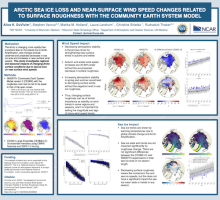Arctic sea ice loss and near-surface wind speed changes related to surface roughness with the Community Earth System Model
Alice
DuVivier
National Center for Atmospheric Research
Poster
The Arctic is undergoing a pronounced and rapid transformation in response to changing greenhouse gasses with increasing temperatures that are amplified compared to the rest of the planet. Other observed changes include reduction in sea ice extent and thickness, and indications that near-surface Arctic winds may be increasing as well, with continuing projected increases in autumn and winter near-surface winds through the end of the century. This study addresses how the wind trends may be driven by changing surface roughness and/or stability in different Arctic regions and seasons, something that has not yet been thoroughly investigated. We analyze 50 experiments from the Community Earth System Model version 2 (CESM2) Large Ensemble and five experiments using CESM2 with an artificially decreased sea ice roughness to match that of the open ocean. We find that with a smoother surface there are higher mean wind speeds and slower mean ice speeds in the Autumn, Winter, and Spring. The artificially reduced surface roughness also strongly impacts the wind speed trends in Autumn and Winter, and we find that atmospheric stability changes are also important contributors to driving wind trends in both experiments. In contrast to clear impacts on winds, the sea ice mean state and trends are statistically indistinguishable, suggesting that near-surface winds are not a major driver of Arctic sea ice loss. Two major results of this work are: 1) the near-surface wind trends are driven by changes in both surface roughness and near-surface atmospheric stability that are themselves changing from sea ice loss, and 2) the sea ice mean state and trends are driven by the overall warming trend due to increasing greenhouse gas emissions and not significantly impacted by coupled feedbacks with the surface winds. Thus, increasing mean winds are likely due to polar amplification rather than a major driver, and better understanding changes in cyclones and other significant wind events and how they change with polar amplification is critical.

duvivier-alice-polar-poster.pdf
(1.59 MB)
